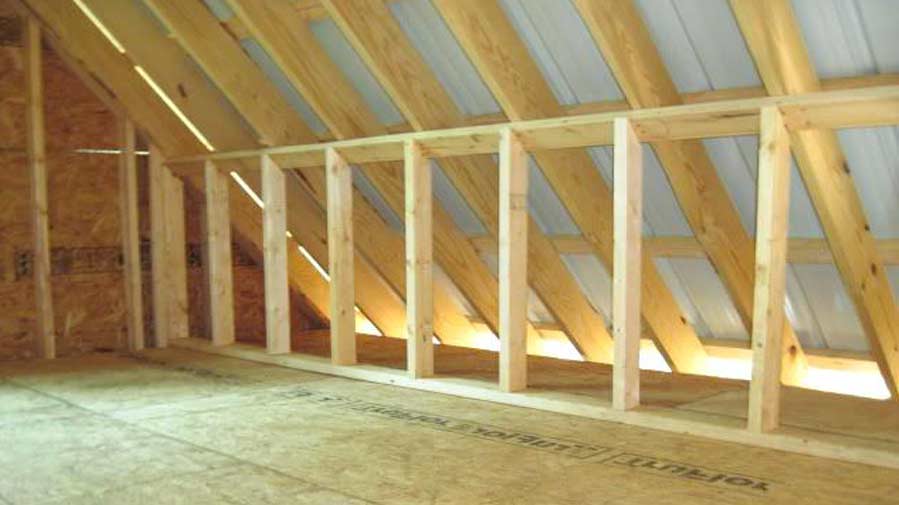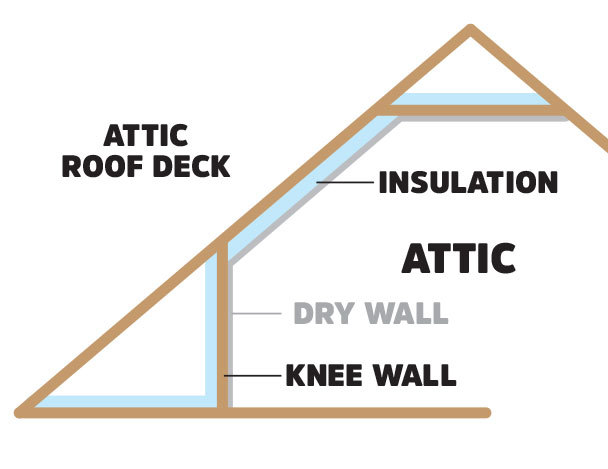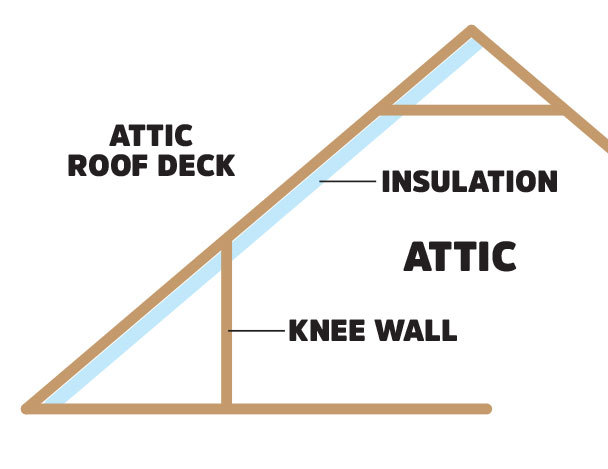What is the Best Way to Insulate a Knee Wall?


Your attic needs insulation, but you have questions on the best way to insulate your knee wall up there.
Not all homes have a knee wall, so let’s first clear up what they are. Basically, if your ceiling is low sloping that leads down a wall or the attic access is perpendicular to the floor, you have knee walls.
RetroFoam of Michigan has been insulating attics since our start in 2002, so we’ve sprayed our fair share of knee wall spaces.
What you need to know though, is the best practice of insulating the knee wall, which isn’t really insulating the wall at all. Don’t worry, we’ll break this all down, so it’s not confusing for you.
Knee Wall Insulation
 When it comes to insulating knee walls, you will want to insulate this space using the same material and method as the rest of your attic.
When it comes to insulating knee walls, you will want to insulate this space using the same material and method as the rest of your attic.
The best materials for the attic, and thus the knee wall, are spray foam, fiberglass, and cellulose.
If you plan to insulate the roof deck of your attic, then you would use spray foam or fiberglass batts. Cellulose is much better suited for the attic flat.
 The thing to keep in mind is the space behind the knee wall is an extension of the roof deck. That’s why up above I said you really aren’t insulating the knee wall at all – it’s really the space behind it. But that is only in the case of insulating the roof deck.
The thing to keep in mind is the space behind the knee wall is an extension of the roof deck. That’s why up above I said you really aren’t insulating the knee wall at all – it’s really the space behind it. But that is only in the case of insulating the roof deck.
If you are insulating your attic flat, then you would insulate the knee wall, cutting off that cubby space from the rest of the conditioned space. If you are insulating the attic flat, just remember you will also need baffles to ensure airflow from the soffit up to the ridge vent, but that’s a whole different article.
Now let’s talk about the best way to insulate knee walls.
Best Way to Insulate Attic or Bonus Room Knee Walls
The Department of Energy’s Building America Solution Center recommends creating an air barrier when insulating the knee wall.
Creating this air barrier not only keeps you from leaking air outside or outdoor air getting inside but when it comes to your attic, it can also help keep your roof in good shape and helps to combat moisture issues. We’ll go more in-depth on this in a moment.
Before we get into the why let’s talk more about the how of the different insulation materials.
Insulating Knee Walls with Cellulose Insulation
Cellulose insulation is only an option when insulating the attic flat.
In this process, most insulation contractors will blown-in cellulose on the attic floor. When it comes to the knee wall, in most cases, the contractor will install the cellulose on the floor of the cubby on the other side of the wall. This is the only instance when the knee wall itself isn’t insulated when the attic flat is done.
In rare instances, they may change materials to insulate the knee wall itself with either wet cellulose or fiberglass batt.
Insulating Knee Walls with Fiberglass Insulation
Fiberglass batts can be installed either on the roof deck or the attic flat.
The batts have to be cut to fit perfectly in the space where they are installed to prevent gaps.
Suppose the roof deck is insulated with fiberglass. In that case, the knee wall itself is not insulated, and the insulation itself continues through to the cubby on the other side of the wall.
If the attic flat is done, the fiberglass is installed on the flat and up the knee wall. A good contractor would also put fiberglass on the floor of the cubby.
One thing to keep in mind with fiberglass and cellulose – is that these materials don’t create an air barrier, so air movement is still possible.
Insulating Knee Walls with Spray Foam Insulation
Of the three materials, spray foam insulation is the only one that creates an air barrier and prevents air movement.
When the roof deck is insulated, the foam is sprayed on the roof's underside right through to the cubby beyond the knee wall. This method completely air seals the envelope of your home.
An added bonus of this method is protecting your roof from damage, specifically from ice dams.
If the attic flat is insulated with spray foam, the knee wall is also sprayed. This method will completely cut that cubby on the other side of the knee wall off from the rest of the conditioned attic space, so any air that might leak into that space has no place to go.
Creating an Air Barrier with Knee Wall Insulation
You now know the best way to insulate the space hidden by your knee wall.
It’s up to you to decide which material is the best fit for your needs. If you would like to learn more about creating an air barrier in your attic space or home in general, check out the Learning Center on our website.
Related Articles
How to Add Cape Cod Attic Insulation: Spray Foam the Knee Wall or Roof Deck
3 Common Insulation Problems with Cape Cod Houses
How Air Sealing Insulation in Your Home Works Like Your Airtight Cooler
About Amanda Emery
Amanda previously has worked as a breaking news and crime reporter, TV news producer, and editor in Flint and Detroit. Throughout her career as a journalist, she has won several awards from The Society of Professional Journalists - Detroit Chapter and the Michigan Press Association. As part of the RetroFoam of Michigan family, Amanda uses her experience as a journalist to write content that will help educate homeowners on the benefits of foam insulation. When Amanda isn’t writing, she’s spending time with her husband and rescued huskies. She also loves knitting, making art, cooking, and hosting dinner and a movie night for friends and family.


